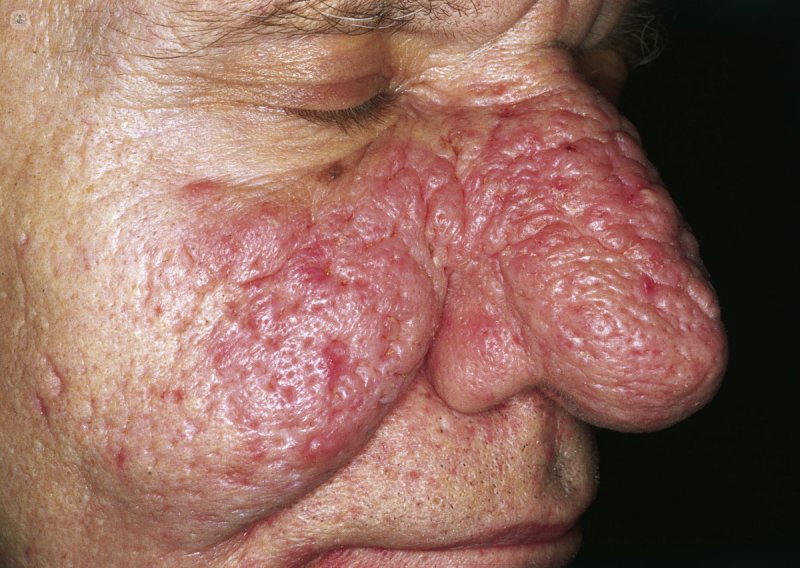Rhinophyma
What is rhinophyma?
Rhinophyma is a progressive skin condition that sometimes affects those with rosacea.
When rosacea develops, sometimes the nose becomes swollen and red, gaining a bumpy surface that changes the nose's shape. The swelling is known as rhinophyma which can appear as the formation of scar-like tissue that may increase over time. Sometimes, rhinophyma can appear on other parts of the face such as the ears and chin, though this is rarer.
Rhinophyma usually only develops in those who have rosacea which has been active and untreated for many years. Rhinophyma mainly affects fair-skinned men aged 50 to 70 years.

How is rhinophyma diagnosed?
Rhinophyma diagnosis is made by looking at the appearance of the skin and whether rosacea is present. If a rhinophyma diagnosis is unclear, a small skin biopsy under local anaesthetic, for examination under the microscope, may be carried out.
Symptoms of rhinophyma include changes in the nose such as:
- Increasing visibility of oil glands;
- A bulbous shape;
- Increased redness;
- Thickening of the skin;
- Yellow and waxy surface.
Causes of rhinophyma
Rhinophyma’s causes are not completely understood. Rhinophyma was once thought to be caused by heavy alcohol consumption. However, this isn’t correct. Rhinophyma occurs equally in people who do not drink alcohol and in those who drink heavily. Although alcohol doesn't cause rhinophyma, it can temporarily dilate blood vessels which can make the appearance of rhinophyma worse. Rhinophyma is much more common in men than in women. The exact causes of this rhinophyma are unknown.
Treatment options for rhinophyma
Medication
Oral isotretinoin is often the first option for rhinophyma treatment. It’s more likely to be beneficial if the rhinophyma is in its early stages and if symptoms aren’t severe.
The primary goal is to treat the underlying rosacea. Topical or oral antibiotics may reduce inflammation and redness in the area.
Some of the most common antibiotics used to treat rhinophyma include metronidazole, tetracycline, and erythromycin.
Moisturiser may also be recommended to prevent skin from drying out.
Long-term medication and other treatment options for rhinophyma, such as regular dermabrasion, may help. Treating rhinophyma as early as possible will give the person the best chance of avoiding permanent disfigurement and prolonged symptoms.
Surgical treatment
Techniques used to improve the cosmetic appearance of rhinophyma include:
- Dermaplaning
- Dermabrasion
- Electrosurgery
- Cryotherapy
- Laser resurfacing
Surgical treatment involves the use of either debridement or a laser instrument to remove excessive thickening of your skin. The procedure is usually done as a day case. It may be done under a local or general anaesthetic.
There is currently no cure for rhinophyma and the symptoms can return after surgery.
How to prevent rhinophyma
It is recommended to protect your skin from the sun by using sun cream with an SPF of at least 30. Lifestyle changes may also be recommended to manage rhinophyma symptoms.
This includes avoiding:
- smoking tobacco;
- alcoholic drinks;
- spicy foods;
- caffeinated drinks;
- rubbing the face;
- too much sunlight;
- extreme temperatures.
Getting rid of these factors can help to reduce the appearance of redness and of blood vessels in some people with rhinophyma.
